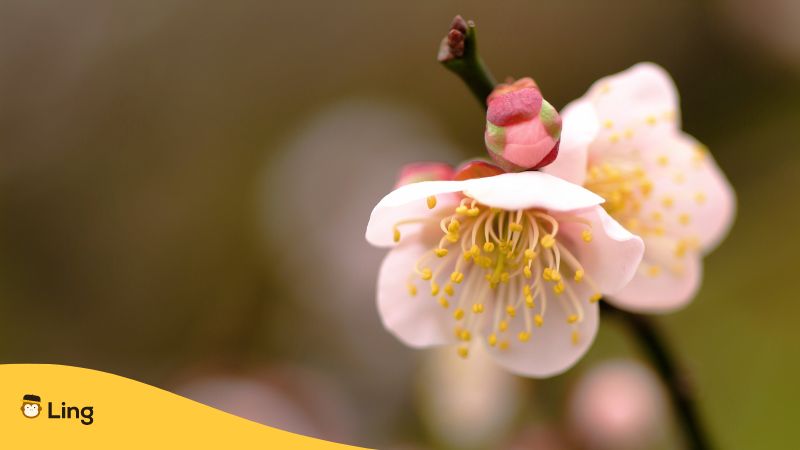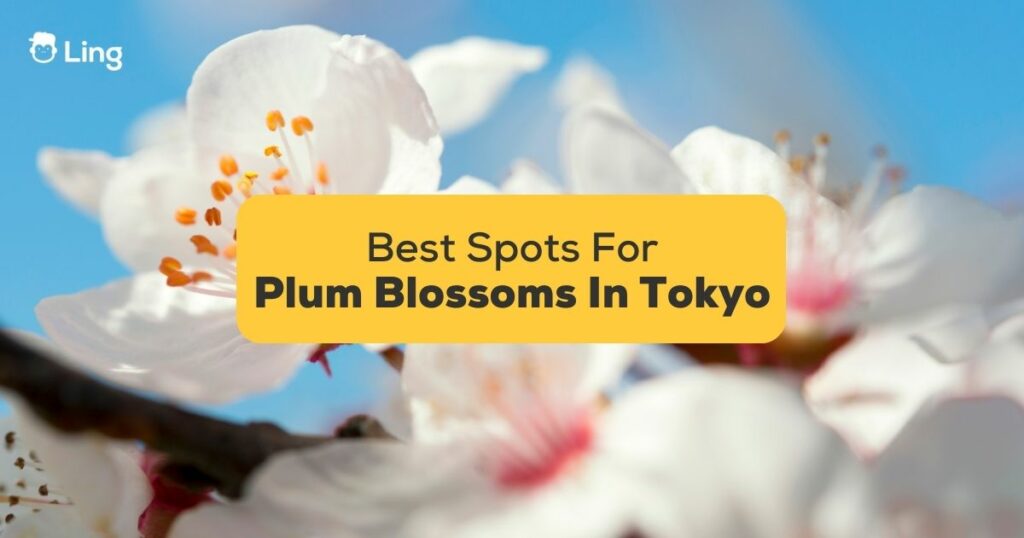Think Japan is just about cherry blossom season? Think again! Actually, there’s an equally stunning plum blossom viewing season actually comes first in February and March. And so in this post, we’ll go over the best viewing spots for Plum Blossoms in Tokyo PLUS some handy Japanese phrases to help you enjoy this wonderful seasonal phenomenon.
Why?
Well, as someone who lived and worked in Japan, I can attest there is far more to Japanese floral appreciation than the Sakura craze in spring. Don’t get me wrong – hanami (花見) is awesome. But it wasn’t until my first February there that I discovered the equally stunning plum blossom viewing season that comes first. I noticed my Japanese colleagues eagerly anticipating and enjoying ume blossoms, heading to gardens and parks to appreciate their transient loveliness.
I came to realize something most foreigners don’t know – that plum blossoms actually mark the first floral phenomenon in Japan’s seasonal calendar. Though they don’t get as much fanfare as the infamous Sakura, ume brings their own joy and poetic magic as the hardy harbingers of spring.
Table Of Contents
@her.atlas springtime in Japan… the UME (plum) blossoms are bursting! 💐💗💗💗 #japan #ume #plumblossom
♬ Lofi – Domknowz
Where To See Plum Blossoms In Tokyo
One of the best things about Tokyo is that you don’t need to travel out to the farther-flung prefectures to experience the beauty of plum blossoms in spring. There are ample stunning displays right in the metropolis’ lush gardens, parks, shrines, and temples. Let’s get to know in this section some of the best spots to hit up by February.
Hanegi Park
Address: 4-38-52 Daita, Setagaya-ku, Tokyo 155-0033, Japan
The park’s location, Umegaoka (which translates to “Plum Blossom Hill”) in Setagaya Ward, should already tip you off about what to expect here. And true to its name, Hanegi Park slays with its amazing collection of gorgeous plum bounty! No wonder why it’s considered the best location for the annual Setagaya Plum Blossom Festival held in late February through March.
On weekends during the festival timeframe, vendors peddle ume-themed items like the classic umeboshi, ume plum wine, ume plum vinegar, and more. If you’re craving something more fitting during the plum festival, you can also snatch up some ume mochi for a chewy dessert on the go.
Yushima Tenjin Shrine
Address: 3 Chome-30-1 Yushima, Bunkyo-ku, Tokyo
Though small, the shrine boasts wondrous natural appeal, especially during plum blossom season. Every year over 300 plum trees representing 50 varieties explode into pink and white finery along the shrine’s staircases and background.
To commemorate the annual ume bloom extravaganza, Yushima Tenjin Shrine puts on a month-long Plum Festival brimming with cultural performances, a lively mikoshi shrine parade, and plenty of street food vendors. Personally, this is my favorite spot, especially during early February, because it’s rarely crowded.
Koishikawa Korakuen Gardens
Address: 1-6-6 Koraku, Bunkyo-ku, Tokyo 112-0004
Given its location, Koishikawa Kōrakuen dazzles visitors all year round as one of Tokyo’s most historic and manicured landscapes. Known as a top hanami spot for cherry blossoms, this picturesque garden also shines during plum blossom season.
From late February through March, over 90 plum tree varieties at Koishikawa Kōrakuen burst into spectacular whites, pinks, and weeping cascade plum blossoms. Unlike festivals at shrines and parks, here, the experience is simply about appreciating their elegant beauty against the garden’s ponds, paths, and traditional Japanese structures.
Shiba Park
Address: 4 Chome-10-17 Shibakoen, Minato City, Tokyo 105-0011, Japan
Fancy viewing plum blossom finery against Tokyo’s iconic Tower backdrop? Then make your way to Shiba Park, located at the base of this defining structure. While only 70 plum trees strong, Shiba Park delivers a spectacle belying its modest size. Blooming in late February, the park’s plum bouquet seems to glow ethereally with the ruby Tokyo Tower lights illuminating trees from behind at night.
Aside from taking Instagrammable shots with Tokyo Tower, visitors to Shiba Park in plum blossom season have plenty of activity options. Pack a bento box and have a picnic under the canopies of pink and white blossoms for a quintessentially Japanese experience. Or wander through the small plum forest during the day, weaving between trees and watching petals flutter down around you romantically.
Kameido Tenjin Shrine
Address: 3 Chome-6-1 Kameido, Koto City, Tokyo 136-0071, Japan
Kameido Tenjin in downtown Tokyo certainly follows suit, wowing visitors every year with over 300 stunning plum trees on its grounds. A famous hybrid tree called “Goken no Ume” stands out amongst the traditional whites and pinks, flaunting a contrast of both red and white blossoms on a single tree. This, along with the shrine’s picturesque arched bridge, draws scores of photography buffs and hanami goers when the plum trees bloom in February.
Despite the crowds, Kameido Tenjin manages to exude a quainter, more local vibe than other major plum viewing destinations in the city. Nuzzled amongst the skyscrapers of “shitamachi” downtown, this tranquil plum sanctuary provides fantastic juxtapositions of urban Japan against cloud-like ume sprays.

Japanese Phrases For Viewing Plum Blossoms
Ready to visit during the Plum Blossom Festival? If yes, then take your ume appreciation to the next level by familiarizing yourself with these Japanese vocabulary words and phrases before heading out!
- Ume (梅) – The Japanese word for plum blossoms
- Umemi (梅見) – Plum blossom viewing
- Kasumi ga yoi! (かすみがよい!) – The haze is beautiful!
- Ume saite imasu ne. (梅咲いていますね。) – The plum blossoms are blooming, aren’t they?
- Ume no kaori ga shite imasu. (梅の香りがしています。) – It smells like plum blossoms.
- Sugata ga totemo utsukushii desu ne. (姿がとても美しいですね。)– Its figure/shape is really beautiful.
- Totemo oishisou desu ne! (とても美味しそうですね!) – Looks very delicious! (In reference to plum-flavored treats sold at festival booths)
Ready To Take Pictures Of Plum Flowers?
Can’t get enough plum petal magic? Then make sure to also check out the Bunkyo Plum Blossom Festival held annually in late February. This extra celebration boasts over 300 trees blooming on the grounds of the Tokyo Dome, along with booths selling ume treats and drinks at Koishikawa Korakuen gardens.
As you enjoy Tokyo’s best plum sanctuaries, be sure to sprinkle some of the useful Japanese phrases into conversation from this guide. Locals will appreciate your knowledge and effort embracing the ume appreciation culture.
Want to boost your Japanese even more? Download the innovative Ling app for bite-sized Japanese lessons accessible wherever your ume adventures take you. Unlock plum insights along with better language comprehension on this floral journey!


































































